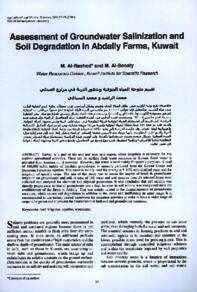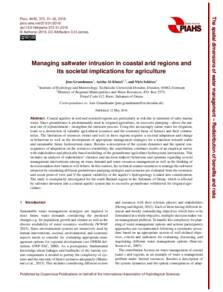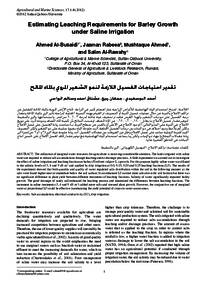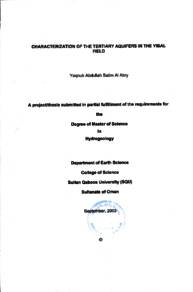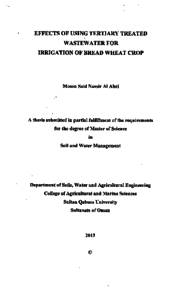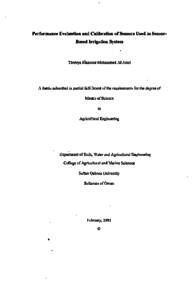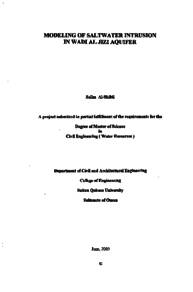وثيقة
Assessment of groundwater salinization and soil degradation in Abdally Farms, Kuwait.
المساهمون
Al-Senafy, M., مؤلف
الناشر
Sultan Qaboos university
ميلادي
2004
اللغة
الأنجليزية
الملخص الإنجليزي
Kuwait is a part of the arid and semi arid region, where irrigation is necessary for any realistic agricultural activities. There are no surface fresh water resources in Kuwait. Fresh water is provided from desalination of seawater. However, this water is used mainly for potable purposes. A total of 100,000 cubic meters of brackish groundwater is annually produced from the Kuwait Group and Dammam Formation aquifers. This water is mainly used for mixing at 5-10% with distilled water and for irigation of specific crops. The aim of this study was to assess the impact of brackish groundwater irrigation on groundwater and soil. A total of 161 water and soil samples from 25 selected farms were collected and analyzed for chemical and physical parameters. It was concluded that soil salinity was directly proportional to that of groundwater and a high increase in soil salinity was recognized since the establishment of the farms in Abdally. That was mainly related to the mismanagement of groundwater resources, which causes soil degradation in addition to the losses and inefficiency in water usage. It is recommended to use tertiary treated wastewater for irrigation activities in order to have a wider range of crops to be grown and to prevent the deterioration in both soil and groundwater resources.
المجموعة
ISSN
2410-1079
URL المصدر
zcustom_txt_2
Al-Rashed, M., & Al-Senafy, M. (2004). Assessment of groundwater salinization and soil degradation in Abdally Farms, Kuwait. Journal of Agricultural and Marian Sciences, 9 (1), 17-19.
الملخص العربي
تقع دولة الكويت ضمن نطاق المناخ الجاف وتعتمد بشكل أساسي على محطات تحلية البحر لتغطية الطلب على مياه الشرب. وبالمقابل فإن حوالي 100000 متر مكعب من المياه قليلة الملوحة تنتج سنويا من الخزانات الجوفية (صخور مجموعة الكويت وطبقات تكوين الدمام ). وتستخدم هذه المياه بشكل رئيسي للخلط مع مياه البحر المقطرة بنسبة تقدر ما بين 5 - 10%، ويستخدم الجزء الباقي من المياه الجوفية لري المحاصيل الزراعية. وقد هدفت هذه الدراسة إلى تقييم أثر استخدام المياه الجوفية قليلة الملوحة في الري على التربية وعلى مخزون المياه الجوفية. ولذلك فقد تم جمع 150 عينة ممثلة للمياه الجوفية وللتربة من 25 مزرعة مختارة، ومن ثم تم إجراء التحاليل الكيميائية والفيزيائية لهذه العينات. وقد خلصت الدراسة إلى وجود علاقة مباشرة وطردية بين نوعية المياه الجوفية وارتفاع ملوحة التربة والتي دلت المعلومات بأنها بازدياد منذ تأسيس منطقة العبدلي الزراعية. ويمكن إيعاز ذلك إلى عدم إدارة موارد المياه الجوفية بشكل صحيح وعدم استخدامها بكفاءة. وقد أوصت هذه الدراسة باستخدام مياه الصرف الصحي المعالجة ثلاثيا للأغراض الزراعية للحصول على تنوع واسع من المحاصيل، ولمنع تدهور التربة ومخزون المياه الجوفية في نفس الوقت .
قالب العنصر
مقالات الدوريات

